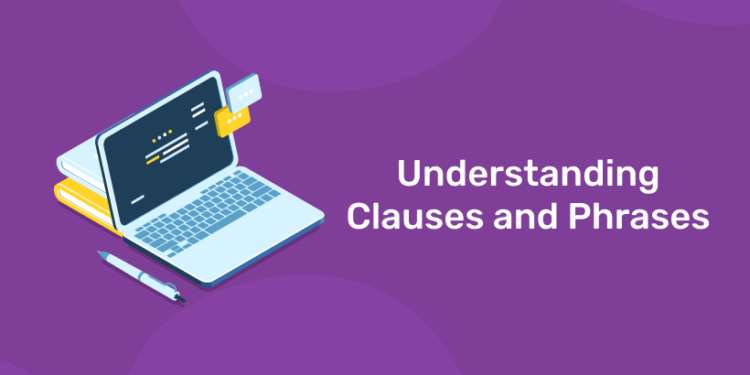Table of Contents
People often struggle with grammar rules that shape clear sentences. Clauses and phrases form the core of English structure. They help express ideas with precision and flow. Imagine reading a book where every line confuses you because words do not connect right. That frustration vanishes when you grasp these basics. This post breaks down clauses and phrases step by step. Readers will gain tools to spot them in any text. Strong writing skills open doors in school, work, and daily talks. Stick around to build that edge and make your words stand out.
What Are Phrases? Types and Examples
Phrases are structural elements in sentences. They put together words that work together but do not have a subject-verb pair.
Even a phrase isn’t just about adding detail, it is part of an elaborate thought. It changes nouns, verbs, or other parts of speech. Writers use phrases to create striking images and to keep texts engaging. Think of them as a supporting structure to the whole idea.
One of the types of noun phrases is the noun phrase. It is a noun and includes words that describe it. So, “the tall man in the red hat” is a noun phrase. The tall man is the person, and “in the red hat” adds details. Name phrases are subject or object in sentences. “The quick brown fox jumps over the lazy dog” . So, “the lazy dog” is the subject noun phrase in this instance, as is “the quick brown fox.” These words give descriptions a powerful clarity and helps readers understand scenes. They prevent bland writing by blending color, size, or position.
One type of verb is a sentence. They contain the verb main as the help verbs. They describe the actions or states in a larger scale. Like “has been running,” then. “Has been” translates as “running” and expresses past action. In the verb phrase “She has been running every morning,” it describes the habit over time. Verb phrases adjust to and modify the tense and mood, providing narratives with flexibility. Writers use them to tell them what they are going to have done, or finished, such as “will have finished” in “By noon he will have finished the report” . This provides a moment of timing that gets readers in the story.
In, in, on or under prepositional phrases. They indicate location, time, or direction. For instance, “under the bridge” tells where something happens.
The first two terms are under the bridge and during storms, meaning the cat sleeps below the bridge during storms. These phrases connect ideas in fine and layers in descriptions. It answers questions such as where or when without extra clauses. Good use of prepositional phrases renders simple statements into powerful stories. For a dramatic backdrop, imagine “on the mountain top at dawn.”
Adjective terms are nouns or pronouns. They use adverbs or prepositions. “Extremally happy about the news” changes the person’s situation. The phrase has emotion in it, because the child, very happy about the news, danced around the room. Adjectives make characters relatable and scenes engaging. They avoid lumps of flat descriptions by naming qualified terms such as “full of energy and ready to go.”
Adverb phrases alter verbs, adjectives, or other adverbs. They tell how, when or where. The term “in a hurry” is literally “She left in a hurry.” It is here that this expression clarifies the style of the action. Adverb phrases can make writing slow. For example, “with great care” in “He handled the glass with great care” means caution. They teach readers the “how” of events, making stories more immersive.
As passive phrases end in -ing or -ed, verb forms end in verb ending in -ing or -ed. They are like adjectives. An object moving through the field is in motion. The dog ran through the field, and the ball, adding action. These words give movement to text. Previous participants write it as: “Tied off the long day, she sat down.” They make sense in narratives, or relief.
Infinitive phrases start with “to” plus a verb. They function as nouns, adjectives, or adverbs. “To win the game” can be a goal in “His dream is to win the game.” As an adjective: “The best way to learn is through practice.” Infinitive phrases express purpose or intent, which motivates readers in instructional content.
Absolute phrases provide extra info without tying directly to the main clause. They include a noun and participle. “Weather permitting, we will go hiking.” Here, “weather permitting” sets a condition. Absolute phrases add nuance, like side notes that enrich understanding.
Phrases boost sentence variety and clarity. They let writers pack more meaning without clutter. Mastering them leads to better communication. Practice spotting phrases in books or articles. This skill sharpens editing and refines your own work. Strong phrases make arguments convincing and stories memorable. Readers stay hooked when text flows with purpose.
What Are Clauses? Types and Examples
1: Which of the sentences below is grammatically correct?
Clauses form complete thoughts within sentences. Each contains a subject and verb. Unlike phrases, clauses can stand alone or depend on others. They drive the main ideas and connect details. Understanding clauses improves sentence construction and logic in writing.
Independent clauses express full ideas. They work as simple sentences. “The sun shines” stands on its own. Writers join them with conjunctions for compound sentences: “The sun shines, and birds sing.” Independent clauses carry the core message. They provide stability in complex texts. For example, “She laughs, but he cries” contrasts emotions clearly.
Dependent clauses need independent ones to make sense. They start with words like “because,” “although,” or “when.” “Because it rained” cannot stand alone. Pair it: “We stayed inside because it rained.” Dependent clauses add reasons, conditions, or times. They deepen explanations. In persuasive writing, they build cases: “Although prices rose, sales increased because quality improved.”
Noun clauses act like nouns. They answer “what” or “who.” “What he said” in “What he said surprised everyone.” Noun clauses serve as subjects or objects. “Whoever wins gets the prize” identifies the winner. They handle abstract ideas in arguments. For instance, “That climate change affects weather is clear” states a fact.
Adjective clauses describe nouns. They often begin with “who,” “which,” or “that.” “The book that I read” specifies which book. In “The man who lives next door is kind,” it adds detail. Adjective clauses make descriptions precise. Restrictive ones, without commas, are essential: “Students who study pass exams.” Non-restrictive, with commas, add extra info: “My brother, who lives in New York, visits often.”
Adverb clauses modify verbs or clauses. They explain why, how, when, or where. “When the bell rings” in “Class ends when the bell rings.” Adverb clauses set conditions: “If you practice, you improve.” They guide sequence in instructions. “As the sun sets, colors change” paints timing.
Relative clauses relate back to nouns. They overlap with adjective clauses. “The house where I grew up” recalls a place. Relative clauses link past and present in stories. They keep narratives cohesive.
Conditional clauses express “if” scenarios. “If it snows, we build a snowman.” They outline outcomes. In advice: “Unless you save money, travel stays a dream.” Conditional clauses persuade by showing cause and effect.
Clauses allow for complex ideas without confusion. They structure debates and analyses. Spot them in news articles to see how pros build points. Clauses make writing flexible. Mix independent and dependent ones for rhythm. This technique draws readers in and holds attention. Clear clauses lead to strong, logical prose that convinces and informs.
Spoken English Course for Guaranteed Confidence and Career Growth
Spoken English Course by Entri App: Enhance your communication skills, gain certification, and boost your career with confidence.
Join Now!Key Differences Between Clauses and Phrases
Clauses and phrases both group words, but they differ in structure and function. Clauses always include a subject and verb. Phrases do not. This core trait sets them apart. A clause can convey a complete idea, while a phrase only adds detail.
Consider independence. Independent clauses stand alone as sentences. Phrases never do. For example, “He runs” is a clause. “In the park” is a phrase. The clause expresses action; the phrase locates it.
Dependent clauses rely on others for meaning. Phrases integrate without such need. “Although tired” as a clause fragment needs completion. “Very tired” as a phrase modifies directly.
In sentences, clauses often form the backbone. Phrases fill in gaps. “The cat, sleeping on the mat, purred softly.” Here, “sleeping on the mat” is a participial phrase describing “cat.” If changed to “which was sleeping on the mat,” it becomes an adjective clause.
Clauses handle tense and voice through verbs. Phrases lack verbs, so they stay static. This makes clauses dynamic for storytelling.
Punctuation varies too. Clauses may need commas or semicolons when joined. Phrases blend in, often without extra marks.
Spotting differences sharpens editing. Misusing them leads to fragments or run-ons. Clauses build arguments with logic. Phrases enhance with color. Balance both for impactful text.
These distinctions empower writers. Apply them to craft sentences that flow and persuade. Readers respond to clear structure. Master this, and your words gain power.
How to Identify Clauses and Phrases in Sentences
Spotting clauses and phrases starts with breaking down sentences. Look for subjects and verbs first. If a group has both, it qualifies as a clause. Without, it falls into phrase category.
Take “The old tree in the yard fell during the storm.” “The old tree” is a noun phrase. “In the yard” is prepositional. “Fell” pairs with subject for the main clause. “During the storm” adds time as a phrase.
Practice with simple sentences. Build up to complex ones. Underline verbs, then match subjects. Leftover groups are phrases.
Use questions to test. Ask “Who or what does the action?” for subjects. “What happens?” for verbs. Clauses answer fully. Phrases answer partly.
In “She sings while cooking dinner,” “She sings” is independent clause. “While cooking dinner” is adverb clause with implied subject.
For phrases, check for missing elements. No verb means phrase. “Running late” lacks subject but describes.
Tools like diagrams help. Map sentences to see parts. Subject-verb lines show clauses. Arrows point phrases to what they modify.
Common pitfalls include mistaking gerunds. “Swimming in the lake” can be phrase or clause part. Context decides.
Read aloud. Pauses often signal clause boundaries. Phrases flow within.
Apply in writing. Revise drafts by labeling. This ensures balance. Too many phrases clutter. Too few clauses weaken.
Daily practice builds instinct. Analyze ads, emails, or books. Soon, identification becomes automatic. This skill boosts confidence in communication. Readers trust clear, structured text.
Conclusion
Clauses and phrases shape effective English. They turn basic words into compelling messages. Grasp their types, differences, and identification to elevate your skills. Apply this knowledge in essays, emails, or chats. Better grammar leads to stronger connections. Keep practicing for lasting improvement. Your words will inspire and persuade others.
Spoken English Course for Guaranteed Confidence and Career Growth
Spoken English Course by Entri App: Enhance your communication skills, gain certification, and boost your career with confidence.
Join Now!Frequently Asked Questions
What is the fundamental, non-negotiable difference between a clause and a phrase?
The fundamental difference is structural: a clause must contain both a subject (who or what the clause is about) and a verb (what the subject is or does). A phrase is any group of words that work together but lacks this subject-verb combination.
-
Clause Example: “The cat sleeps.” (“cat” = subject, “sleeps” = verb)
-
Phrase Example: “On the soft rug.” (This describes location but has no subject or verb).
This distinction is crucial because it dictates how they function. A clause can express a complete thought (if independent) or a dependent idea. A phrase can only act as a single part of speech (e.g., a noun, adjective, or adverb) to add detail to a clause.
Can a clause ever consist of just two words, and is it still grammatically complete?
Yes, absolutely. A clause can be grammatically complete with just two words: a subject and a verb. This forms a simple sentence, also known as an independent clause.
-
Examples: “She writes.” “Birds fly.” “They disagreed.”
These are complete clauses because they have a clear subject performing an action (verb), forming a coherent thought that can stand alone.
How do dependent clauses and long, complex phrases differ, given both cannot stand alone as a sentence?
The difference lies in why they cannot stand alone. A dependent clause is incomplete because it begins with a subordinating conjunction (e.g., because, although, when) or a relative pronoun (e.g., who, which, that), which creates a sense of expectation. It has a subject and verb but does not form a full idea.
-
Dependent Clause: “Because the market closed.” (We need to know what happened as a result).
A phrase cannot stand alone simply because it is a fragment; it lacks the essential subject-verb structure needed to form any complete thought, regardless of its length.
-
Complex Phrase: “Running quickly through the dark and winding forest path.” (This is a long descriptive fragment, but it has no subject).
What are the different types of phrases and how does each one function to enhance writing?
Phrases function as specific parts of speech to add precision and variety:
-
Noun Phrase: Acts as a subject or object. (“The ambitious young entrepreneur launched her company.”)
-
Verb Phrase: Shows the action or state of being, including tense. (“She has been planning this for years.”)
-
Prepositional Phrase: Acts as an adjective or adverb to show location, time, or direction. (“The keys are on the kitchen counter.”)
-
Adjective Phrase: Describes a noun or pronoun. (“He was extremely confident in his abilities.”)
-
Adverb Phrase: Modifies a verb, adjective, or another adverb to tell how, when, or where. (“She completed the task with incredible speed.”)
-
Participial Phrase: Acts as an adjective, starting with a present (-ing) or past (-ed) participle. (“Exhausted from the journey, he collapsed into bed.”)
-
Infinitive Phrase: Begins with “to + verb” and can act as a noun, adjective, or adverb. (“His goal is to learn French.”)
-
Absolute Phrase: Modifies the entire sentence, adding context or detail without a direct grammatical link. (“The ceremony concluded, the graduates celebrated.”)
How do the various types of clauses contribute to building complex and logical arguments?
Clauses allow writers to connect ideas with logical relationships, which is essential for argumentation and analysis.
-
Independent Clauses: State the core claims or facts. (“Sales increased by 20%.”)
-
Dependent Adverb Clauses: Explain the reason, condition, or time behind a claim. (“Because the new marketing campaign was successful, sales increased by 20%.”)
-
Dependent Adjective Clauses: Provide essential definition or extra description about a noun. (“The strategy, which was initially considered risky, paid off.”)
-
Dependent Noun Clauses: Allow you to embed entire ideas as subjects or objects. (“What the data proves is that our approach works.”)
By combining these, you move from simple statements to sophisticated, logical prose that shows cause and effect, defines terms, and acknowledges counterpoints.
What is the step-by-step strategy for accurately identifying clauses and phrases within a complex sentence?
-
Find all the verbs: Identify every action or state-of-being word (e.g., runs, is, has been, thought).
-
For each verb, find its subject: Ask “who?” or “what?” in front of the verb.
-
Label the Clauses: Every group containing a subject-verb pair is a clause. Determine if it’s independent (can stand alone) or dependent (starts with a word like because, if, who, when).
-
Label the Phrases: The remaining groups of words that lack a subject-verb pair are phrases. Identify their type based on their function (e.g., a prepositional phrase starting with in, on, at; a participial phrase starting with an -ing or *-ed* word).
Example: “The manager, who approved the budget, will present her report at the meeting.”
-
Verbs: approved, will present
-
Subjects: who (for approved), manager (for will present)
-
Clauses: “…who approved the budget” (dependent adjective clause), “The manager… will present her report” (independent clause).
-
Phrases: “at the meeting” (prepositional phrase).
What are the most common errors people make when confusing phrases and clauses, and how can they be avoided?
The most common error is treating a phrase as if it were a complete sentence, resulting in a sentence fragment.
-
Error: “She worked all day. Exhausted from the long hours.” (“Exhausted from the long hours” is a participial phrase, not a clause).
-
Correction: “She worked all day and was exhausted from the long hours.” or “Exhausted from the long hours, she worked all day.”
Avoidance Strategy: Always check that every sentence you write contains at least one independent clause (a subject-verb pair that can stand alone).
How does mastering clauses and phrases directly improve the persuasiveness and engagement of one's writing?
Mastery allows for sentence variety, which creates rhythm and maintains reader interest. A text with only short, simple sentences feels choppy and simplistic. Conversely, a text with only long, convoluted sentences is difficult to follow. Skillful writers mix clause and phrase structures to control pacing, emphasize key points, and weave in supporting details seamlessly. This flow makes arguments more persuasive and narratives more immersive, as the reader is guided smoothly through complex ideas without frustration.
Beyond basic grammar, what is the rhetorical impact of choosing a phrase over a clause (or vice versa) in a sentence?
Choosing a phrase over a clause often creates a more concise and streamlined sentence. Phrases can pack descriptive power without the grammatical weight of a full clause.
-
With Clause: “The report, which was filled with critical data, was ignored.”
-
With Phrase: “The report, filled with critical data, was ignored.”
The version with the phrase is more direct and impactful. Conversely, using a clause allows you to express a more complex logical relationship (like cause and effect) that a phrase cannot.
How can someone actively practice and integrate the knowledge of clauses and phrases into their daily communication?
-
Active Reading: Select a paragraph from a well-written article or book. Deconstruct it, labeling each clause and phrase. Notice how the author builds sentences.
-
Sentence Combining: Take simple sentences and combine them into a single, sophisticated sentence using dependent clauses and phrases. (e.g., “The sun set. The colors were beautiful. We felt at peace.” -> “As the sun set with beautiful colors, we felt at peace.”)
-
Editing and Revision: Review your own emails, reports, or essays. Look for opportunities to replace wordy clauses with crisp phrases or to break up long strings of phrases with a clear, strong clause for emphasis. This conscious practice builds instinct over time.











